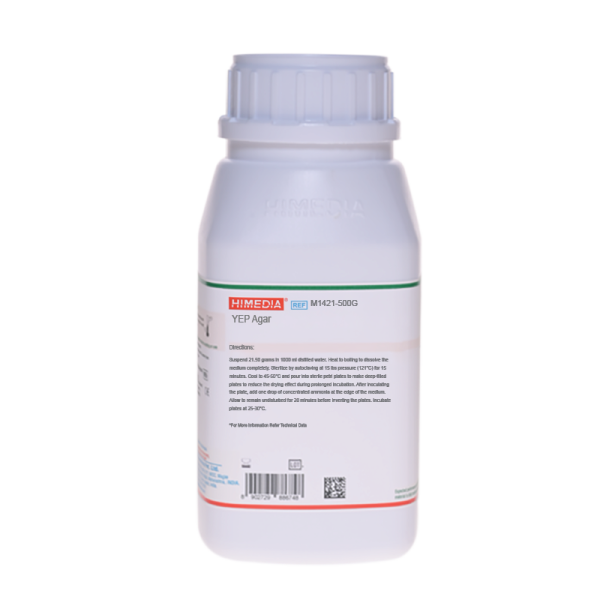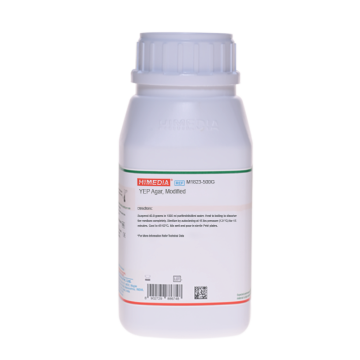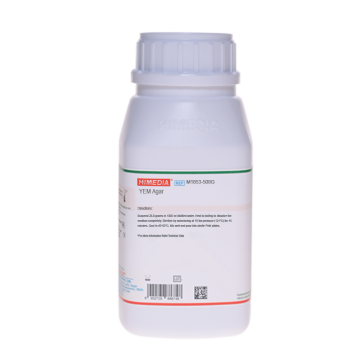 Your enquiry has been submitted
Your enquiry has been submitted
YEP Agar
Intended use
For isolation of dimorphic fungi from clinical and other nonclinical samples.
Composition
| Ingredients | g/L |
|---|---|
| Yeast extract | 1.000 |
| Disodium hydrogen phosphate | 0.200 |
| Potassium dihydrogen phosphate | 0.300 |
| Phenol red | 0.001 |
| Agar | 20.000 |
Formula adjusted, standardized to suit performance parameters
Directions
Suspend 21.50 grams in 1000 ml distilled water. Heat to boiling to dissolve the medium completely. Sterilize by autoclaving at 15 lbs pressure (121°C) for 15 minutes. Cool to 45-50°C and pour into sterile petri plates to make deep-filled plates to reduce the drying effect during prolonged incubation. After inoculating the plate, add one drop of concentrated ammonia at the edge of the medium. Allow to remain undisturbed for 20 minutes before inverting the plates. Incubate plates at 25-30°C.
Principle And Interpretation
Smith and Goodman developed YEP Agar for the primary isolation of dimorphic fungi from clinical specimens (1). Ammonium hydroxide is added to the medium which helps in inhibiting bacteria, yeasts and saprophytic fungi (2,3). Phenol red changes the colour of the medium from pale tan to pink to show that the 1 N NH4OH has been applied to Yeast extract supplies B-complex vitamins, amino acids and carbohydrates to support fungal growth. Phosphate buffer maintains a slightly acidic pH.
Type of Specimen
Clinical specimen: Skin; Nonclinical: Environmental, Soil samples
Specimen Collection and Handling
For clinical samples follow appropriate techniques for handling specimens as per established guidelines (4,5). After use, contaminated materials must be sterilized by autoclaving before discarding.
Warning and Precautions
In Vitro diagnostic Use. For professional use only. Read the label before opening the container. Wear protective gloves/protective clothing/eye protection/ face protection. Follow good microbiological lab practices while handling specimens and culture. Standard precautions as per established guidelines should be followed while handling clinical specimens. Safety guidelines may be referred in individual safety data sheets.
Limitations
- Colony growth should be examined microscopically for switching nature of dimorphic fungus that has grown.
- Prolonged incubation time may result in growth of undesirable organisms.
- Additional selective media and biochemical tests are necessary for identification of fungal growth.
Performance and Evaluation
Performance of the medium is expected when used as per the direction on the label within the expiry period when stored at recommended temperature.
Quality Control
Appearance Light yellow to beige homogeneous free flowing powder
Gelling
Firm, comparable with 2.0% agar gel.
Colour and Clarity of prepared medium
Yellow to orange coloured clear to slightly opalescent gel forms in Petri plates.
Cultural Response
Cultural characteristics observed after an incubation at 25-30°C for 1-4 weeks.
| Organism | Inoculum | Growth | Recovery |
|---|---|---|---|
| Blastomyces dermatidis ATCC 14112 | 50-100 | good | |
| Staphylococcus aureus subsp. aureus ATCC 25923 (00034*) | 50-100 | none-poor | <= 10% |
Key: (*) - Corresponding WDCM numbers
Storage and Shelf Life
Store between 10-30°C in a tightly closed container and the prepared medium at 2-8°C. Use before expiry date on the label. On opening, product should be properly stored dry, after tightly capping the bottle in order to prevent lump formation due to the hygroscopic nature of the product. Improper storage of the product may lead to lump formation. Store in dry ventilated area protected from extremes of temperature and sources of ignition Seal the container tightly after use. Product performance is best if used within stated expiry period.
Disposal
User must ensure safe disposal by autoclaving and/or incineration of used or unusable preparations of this product. Follow established laboratory procedures in disposing of infectious materials and material that comes into contact with clinical sample must be decontaminated and disposed of in accordance with current laboratory techniques (4,5).
Reference
- Smith and Goodman, 1974, Am J. of Clin Rathol., 62:276
- Haley and Callaway, 1978, Laboratory methods in Medical Mycology. HEW Publication No. (CDC) 78-8361. Centre for Diseases Control, Atlante, Ger.
- Larone Mitchell and Walsh. 1999 Murray, Baron Pfaller Gerover and Yolken (ed)- Manual of Clinical Microbiolgy, 7th ed. American Society for Microbiology, Washington, D.C.
- Isenberg, H.D. Clinical Microbiology Procedures Handbook. 2nd Edition.
- Jorgensen, J.H., Pfaller, M.A., Carroll, K.C., Funke, G., Landry, M.L., Richter, S.S and Warnock., D.W. (2015) Manual of Clinical Microbiology, 11th Edition. Vol. 1.
| Product Name | YEP Agar |
|---|---|
| SKU | M1421 |
| Product Type | Regular |
| Physical Form | Powder |
| Origin | Animal Free (Microbial) |
| Packaging type | HDPE |
| References | 1.Smith and Goodman, 1974, Am J. of Clin Rathol., 62:2762.Haley and Callaway, 1978, Laboratory methods in Medical Mycology. HEW Publication No. (CDC) 78-8361. Centre forDiseases Control, Atlante, Ger.3.Larone Mitchell and Walsh. 1999 Murray, Baron Pfaller Gerover and Yolken (ed)- Manual of Clinical Microbiolgy, 7th ed.American Society for Microbiology, Washington, D.C.4.Isenberg, H.D. Clinical Microbiology Procedures Handbook. 2nd Edition. |
| Customized Product Available | No |







